Texas
| |
 |
Addison |
Texas |
USA |
Sun Alignment |
Dial 1089 |
| This is a sun alignment arch about 23 feet (7m) high and 650 feet (20m) in length and 5 foot (1.5m) wide, It is made of Corten steel, a metal whose surface oxidizes quickly, leaving a rusty chocolate color that provides a textured surface. The archAt the top of the arch are keystone wedges that funnel sunlight on the equinox at local solar noon onto a steel sphere on the ground below. The original model for the arch was made in bronze in 1974 and titled “Rainbow arch restructured”. |
| |
| |
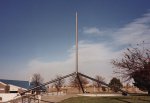 |
Amarillo |
Texas |
USA |
Obelisk or Vertical Gnomon |
Dial 67 |
| The Centennial Time Tower begins as a tetrahedron of stainless steel pipes each 18 feet long. Then a central pipe towers to the sky, giving an overall height of about 50 feet. The Time Tower is situated on a circle about 100 feet in diameter. The dial was erected for the hundredth anniversary of the discovery of Helium. Each individual pipe is a time capsule filled with helium. The plaque under the center of the tower shows when each one is to be opened. |
| |
| |
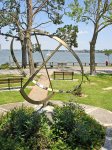 |
Clear Lake Shores |
Texas |
USA |
Armillary Sphere |
Dial 673 |
| An approximately four foot diameter ring equatorial dial of painted steel with Roman numeral hour marks and a long double-bar steel gnomon. Ring is sagging somewhat at base support, perhaps from being climbed upon. |
| |
| |
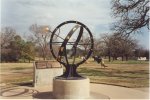 |
College Station |
Texas |
USA |
Armillary Sphere |
Dial 134 |
| Called the Texas A&M Armillary Sphere, this sundial is 60 inches in diameter. Made of wrought iron, it has one large vertical ring representing the meridian at College Station. Attached to the inside of this ring is a wide band representing the celestial equator. The outside of this band is decorated with gold signs of the zodiac. On the inside are gold Roman numerals for each hour. A rod with gold tip and ornate fan is the gnomon. A metal plaque mounted nearby gives a description of the dial and EoT corrections. Dial donated by Searcy Bracewell, class of '38. Built by Kenneth Lynch & Sons, Wilton, CT. Dial sits atop a concrete cylinder, 2 foot high, 3 foot diameter. |
| |
| |
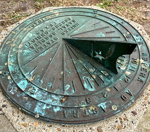 |
Corpus Christi |
Texas |
USA |
Horizontal Dial |
Dial 1083 |
| Farenholt sundial for U.S. Naval Hospital Corpus Christi Texas. This cast bronze dial was designed and commissioned by RADM Farenholt for U.S. Naval Hospitals at bases where he was commanding officer, visited, or had special meaning to him. The dial is 18 inches (46cm) in diameter. The outer chapter ring has the motto, followed by a chapter ring with Arabic hours 6am to 6pm, raised hour lines that radiate from near the foot of the gnomon and short half-hour lines. The gnomon has graceful curves and a star cut-out in the center. Below the gnomon is the naval command name, followed by the commissioning date in the southern portion of the hours chapter ring. |
| |
| |
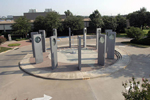 |
Dallas |
Texas |
USA |
Horizontal Dial |
Dial 385 |
| This is large horizontal dial with a 20-foot-long polar gnomon that rises obliquely from the center of a 34-foot-diameter circle. The hour lines are embedded in the terrazzo pavement showing hour marks and quarter hour ticks. Hour labels (standard time 6-7 and daylight-saving time 7-8) are etched into 12-inch diameter stainless steel plates, each tipped toward the dial's center and supported on a 6-inch-high bollard. The tick marks run further, extending from 5:30am to 7:15 standard time. Hour marks and labels are offset for site longitude, making the time correction between solar and civil time no more than +/- 15 minutes, depending on season. The stainless-steel gnomon has a rectangular cross section that tapers from 12 x 4 inches at the base to 4 x 4 inches at the upper end. The center of the gnomon's shadow (not the shadow's edge) indicates the time. The terrazzo circular plaza is slightly beveled (a squat cone) for proper runoff of rain. The cone's apex coincides with the base of the gnomon and is 10 inches higher than the circumference of the 34-foot circle. The layout of time lines takes this radially sloping surface into account. The terrazzo pavement also includes an embedded polar map of the world adjusted in longitude so that the longitude of Dallas with a star at the dial's location in Texas is due south of the gnomon. |
| |
| |
 |
Early |
Texas |
USA |
Horizontal Dial |
Dial 1107 |
| This is a monumental sundial with a gnomon is 52 feet (16m) long and 24 feet (7.3m) tall at the point. Tall concrete pillars mark the hours from 7am to 5pm in an offset circle 60 feet (18m) in diameter. The 7:00am/5:00pm pillars are 7 feet (2.1m) tall, and stair-step in height 1 foot (0.3m) for each hour until the noon pillar at 12 feet (4m) tall. The pillars are asymmetrically arranged to accommodate the longitude offset from Central Standard Time at 90° longitude. The pillars are set at the outer edge of a 6 foot (2m) concrete walkway and back lit by LEDs at night. Directly under the tip of the gnomon are brass cardinal direction letters, memorial bricks and a rock garden, under which a time capsule has been buried to be opened on the city's 100th birthday. At night, LED lights in gnomon cut-outs show stars, the moon, and planets. There is a plaque in front of each pillar showing who made the donation for that particular pillar. Memorial bricks were another fundraiser. Around $107k in donations was raised in addition to grants from the city for the sundial project. |
| |
| |
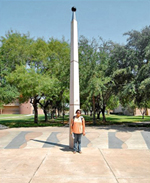 |
Edinburg |
Texas |
USA |
Obelisk or Vertical Gnomon |
Dial 478 |
| A vertical gnomon 19.58 feet tall projects its shadow onto a modernistic courtyard. The courtyard has inlays showing the hour corrected for the equation of time, give a sinuous set of curves to the hour lines. |
| |
| |
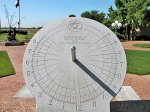 |
Euless |
Texas |
USA |
Equatorial Dial |
Dial 602 |
| A granite and stainless steel equatorial dial approximately 6 feet high. Equation of time and user information are shown on a granite lab in front of the dial. |
| |
| |
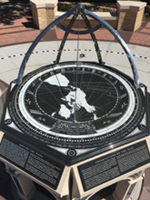 |
Fort Worth |
Texas |
USA |
Horizontal Dial |
Dial 937 |
| This elegant horizontal dial is more than just a horizontal sundial. The designer, William Andrewes refers to this instrument as a "longitude dial". First designed by Franz Ritter in 1607, the dial plate contained a gnomonic map projection. The TCU dial has a map projection centered on Fort Worth. The dial is about 48 inches in diameter, made of black granite with excellent inset white marble for dial lines and a chapter ring delineated to the minute. An outer chapter ring gives the months of the year and corresponding minute correction of the Equation of Time. The gnomon is a thin rod with nodus to cast shadows on the map's tropic of Cancer, equator, and tropic of Capricorn. Other day lines record significant dates for Texas Christian University. |
| |
| |
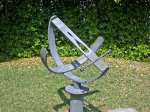 |
Galveston |
Texas |
USA |
Equatorial Dial |
Dial 318 |
| This is an equatorial dial 3 x 4 feet tall, set up for the latitude and longitude of Galveston Texas. Corrections for the Equation of Time are cut as an analemma into the broad gnomon that rotates on a polar rod. The Equatorial time ring has hour lines viewed as standard time or DST at 5 minute intervals. |
| |
| |
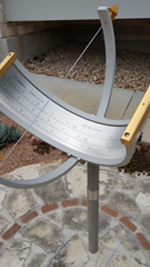 |
Georgetown |
Texas |
USA |
Equatorial Dial |
Dial 1092 |
| A brilliant equatorial dial, constructed of stainless steel, aluminum, and gold-plated brass. Scales for local apparent time, Central Standard time, and Central Daylight time where the Equation of Time on a plaque fixed to the meridian circle. Dial mounting incorporates a unique gimbal to allow precise adjustment of N-S alignment and a meridian ring clamp with plate that mounts to the pedestal pole using adjustment bolts. |
| |
| |
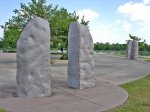 |
Houston |
Texas |
USA |
Sun Alignment |
Dial 684 |
| A large concrete, paving stone and standing stone calendrical dial with interior labyrinth. Outer ring shows NESW alignments. Four split standing stone portals are aligned for summer and winter solstice sunrise and sunset. An inner ring contains 13 trees representing the 13 cycles of the moon. |
| |
| |
 |
Houston |
Texas |
USA |
Horizontal Dial |
Dial 1115 |
| In the Sharp Family plot is a lovely statute titled Roses of Yesterday of a lady holding wilted roses in one arm and a sundial in the other. The dial itself is circular, approximately 12 inches (30.5cm) in diameter. The hour marks in a narrow chapter ring are Roman Vi to VI, divided into quarter hours. The original gnomon was set to the 6-6 line at the extreme south of the dial, but until circa 2019-2020 the gnomon had long been missing, Since then, a new gnomon has been installed but it is a disaster: It is set backwards, it is the wrong size, and cut at the wrong angle for Houston. It would be a service to the lovely statue and dial to remove the gnomon. |
| |
| |
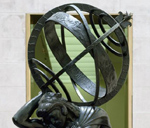 |
Houston |
Texas |
USA |
Armillary Sphere |
Dial 863 |
| The armillary sundial is part of the statue Hercules Upholding the Heavens. The statue portrays the ancient Greek hero Hercules performing the eleventh of his twelve labors, holding the heavens on his back for Atlas. The bronze sculpture is 1,650 pounds and over 10 feet tall. In 1917 Paul Manship was asked by Charles Schwab (Bethlehem Steel) to create this sculpture for his garden at his newly completed mansion. |
| |
| |
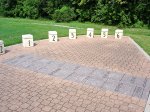 |
Houston |
Texas |
USA |
Analemmatic Dial |
Dial 686 |
| A large analemmatic dial of paving stones, square limestone hour posts with Arabic hour numerals and polished granite date line. Hour numerals show Standard Time. Dial has a concrete border around perimeter. |
| |
| |
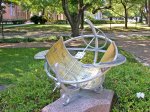 |
Houston |
Texas |
USA |
Cylindrical Dial |
Dial 683 |
| A 32 inch partial armillary of anodized aluminum and steel with wide equatorial and horizon rings and with equinoctial colure, Arctic and Antarctic circle rings. The gnomon includes an aperture to project a solar image on the wide equatorial ring, which includes EOT corrections, graphic for date determination and Zodiacal symbols. Reverse of gnomon aperture includes the university crest. Horizon ring graphic shows time of sunrise/sunset throughout the year. Dial is partially shaded by surrounding trees. Dial sits on an approximately 4 foot high polished granite pedestal |
| |
| |
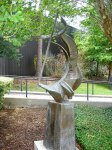 |
Houston |
Texas |
USA |
Sculpture/Artwork |
Dial 275 |
| An 85 inch high bronze sundial-like sculpture with elevated horizontal semicircular ring and steeply inclined bar up from base. Pegs and marks on ring suggest hour marks but design is wrong for location.
Work is dedicated to exploration of space and has been relocated to a very shady area. |
| |
| |
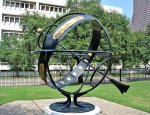 |
Houston |
Texas |
USA |
Armillary Sphere |
Dial 244 |
| A 72 inch painted steel armillary dial with meridian, equatorial, horizon, Arctic and Antarctic rings. Equatorial ring has hourly Roman numerals and zodiacal symbols on its exterior.
A bronze plaque on the base explains the armillary operation and provides a table of combined EOT and longitude corrections. Since Houston is more than 5 degrees from the time zone meridian, the longitude correction is almost 22 minutes, greater than the largest EOT correction, resulting in the combined corrections to always add to the dial time. Dial is mounted to a two foot diameter concrete pedestal.
This dial was restored in 2000 by the Houston Municipal Art Commission funded by Searcy and Elizabeth Bracewell. |
| |
| |
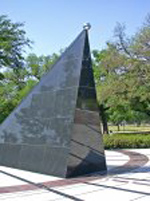 |
Houston |
Texas |
USA |
Horizontal Dial |
Dial 68 |
| Monumental size sundial with a black granite gnomon shaped as a tetrahedral with a small silver ball nodus at the peak. The 12 foot gnomon has a slope of 29.72 deg matching the latitude of Houston. The dial face is white granite with black granite stripes for hour lines, each marked by Roman numerals.granite stripes for hour lines. Along each hour line are markers for month pairs when the shadow of the nodus passes over. These markers are connected by thin declination lines, including the limits of summer and winter solstice and the straight line showing the equinox. |
| |
| |
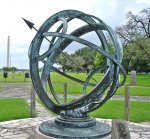 |
La Porte |
Texas |
USA |
Armillary Sphere |
Dial 216 |
| Approximately 6 foot diameter bronze armillary dial with equatorial, meridian and equinoctial colure rings and with Arctic and Antarctic circle rings. Hour lines have 5 minute marks and Roman numerals. Equatorial ring has Zodiacal signs. Base shows the Great Seal of Texas and includes a bronze eternal flame.
Names of fallen heroes are inscribed on the base and paths to and from the dial lead to location of Sam Houston's troops prior to the battle of San Jacinto. The San Jacinto Monument is seen in the distance. |
| |
| |
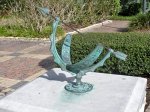 |
League City |
Texas |
USA |
Equatorial Dial |
Dial 678 |
| A small ornate bronze equatorial dial with Roman numeral hours marked on inside of equatorial ring and Zodiacal signs on back side and also on base of dial. Dial is places on a flagstone and cement pedestal. |
| |
| |
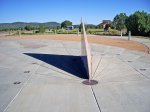 |
McDonald Observatory |
Texas |
USA |
Horizontal Dial |
Dial 771 |
| A monumental horizontal dial on a cast concrete base with a 5 foot high polished granite gnomon. Hour lines radiate from the gnomon root and hour markers with Arabic numerals are placed on a square about the gnomon. Instructions for reading the dial are engraved on the side of the gnomon. |
| |
| |
 |
Nassau Bay |
Texas |
USA |
Horizontal Dial |
Dial 714 |
| A cast concrete horizontal dial with a rugged steel water pipe gnomon. Dial face has hour and half hour marks with Roman hour numerals showing CDST and a compass rose with dial coordinates. A graph marked in the concrete shows EOT correction. |
| |
| |
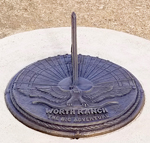 |
Palo Pinto |
Texas |
USA |
Horizontal Dial |
Dial 890 |
| The 21 inches in diameter sundial started as a sculpture. A call went out to the boy and girl scouts (and alum men and women) to contributed fossils, and other artifacts. This included an arrowhead found at camp. These objects were incorporated into the finished wax, with the arrowhead embedded on the style edge at the very tip of the gnomon. A mold was taken of the completed sculpture and used to create a casting wax replica of the sculpture. |
| |
| |
 |
Port Arthur |
Texas |
USA |
Equatorial Dial |
Dial 446 |
| A large Erickson Monument polar equatorial dial of light colored granite, approximately 6 feet in diameter and 6 inches thick. The gnomon shaft is steel, extending from the ground through the dial plate and outward another two feet. The base is a simple tier of raised concrete. 24 hours are inscribed on each side of the dial (summer and winter) as radiating lines with Arabic numbers at the end. Time is graduated by half-hour and 5 minute marks. Two equation of time graphs, each about 3 x 6 feet engraved in granite, are set at the north and south ends of the dial, providing corrections from Apr-Sep, and Oct-Mar. [An interesting note about the engraving for the Apr-Sep graph: The line originally said "For daylight savings time, subtract one hour", the word "subtract" was filled in and "you add" was inscribed over it.] In the top quadrant of the dial (both obverse and reverse) where the sun's shadow will never cast, are the names of cities in 16 different Time Zones. A beautiful and well-crafted sundial, it makes a fitting Seaman's Memorial. |
| |
| |
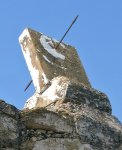 |
San Ygnacio |
Texas |
USA |
Equatorial Dial |
Dial 571 |
| A stone equatorial dial with an iron gnomon. Inscribed on both sides with hour lines. Placed above an entrance to a walled fort also built in 1851. Legend says Jose Villarreal designed and built the dial to celebrate his escape in 1820 as a child after capture by Lipan Apache Indians and being guided by the north star in his return home. Dial Recorder Mary Garza is the great-great-granddaughter of Jose Villarreal. |
| |
| |
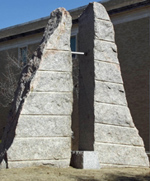 |
Sherman |
Texas |
USA |
Noon Mark or Meridian Dial |
Dial 902 |
| Outside the library are two stone granite guardians about 12 feet tall. They create a noon marker along a low stone wall set along the solar meridian. There are three markers rods set horizontally across the top of the wall that catch the shadow of a horizontal bar set between the two granite pillars. The shadow falls on the farthest horizontal rod on the wall at winter solstice. During the summer solstice, the shadow falls on the nearest rod to the granite block. And on the spring and fall equinox, the shadow falls on the middle rod. |
| |
| |
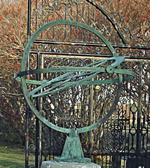 |
Terrel |
Texas |
USA |
Armillary Sphere |
Dial 1049 |
| When is a sundial not a sundial? At first glance it appears to be an armillary sphere, but upon closer inspection, it is missing both a gnomon rod and an equatorial ring to mark the hours. Then, in another view of the dial we see that the angled ring with spokes actually contains hour numbers and could be the missing equatorial ring. Further, it a rod had been attached perpendicular to the ring, and the ring were tilted to the co-latitude, we'd have a working armillary sundial. The missing gnomon rod may have fastened to the meridian ring. Bottom line: with some care, this sundial can be saved and become a working sundial again. |
| |
| |
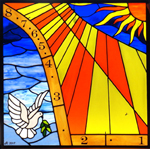 |
Waring |
Texas |
USA |
Vertical Dial |
Dial 870 |
| This is a rare American stained glass sundial, accurately telling time and season. It occupies the center panel of a five panel window that forms a cross. The vertical sundial panel measures 28x28 inches and declines 48° west of south, so it only functions in the afternoons. The dial is longitude corrected and indicates Daylight Saving Time when readings are adjusted using the Equation of Time. The gnomon is a 3/4 inch brass ball nodus attached by a non-polar axis rod to the aluminum Sussman window frame. It is the only stained glass sundial in the world that uses frosted colored stained glass to enhance the view of the nodus shadow. It has three seasonal date lines, a solar noon mark, and other marks showing special anniversary dates. It contains the traditional fly, seen on the the lower yellow panel between 1pm and 1:30pm. |
| |
| |
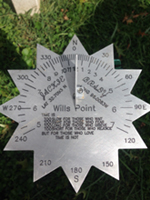 |
Wills Point |
Texas |
USA |
Horizontal Dial |
Dial 884 |
| This starburst sundial is 6-3/4 inches in diameter, made of 1/8 inch aluminum plate. The dial is actually set in a 12-point compass rose, showing the azimuth every 30 degrees. Time marks are every 15 minutes with hours in Arabic numerals. All marking, latitude, longitude, and inscription are engraved into the dial plate. |
| |